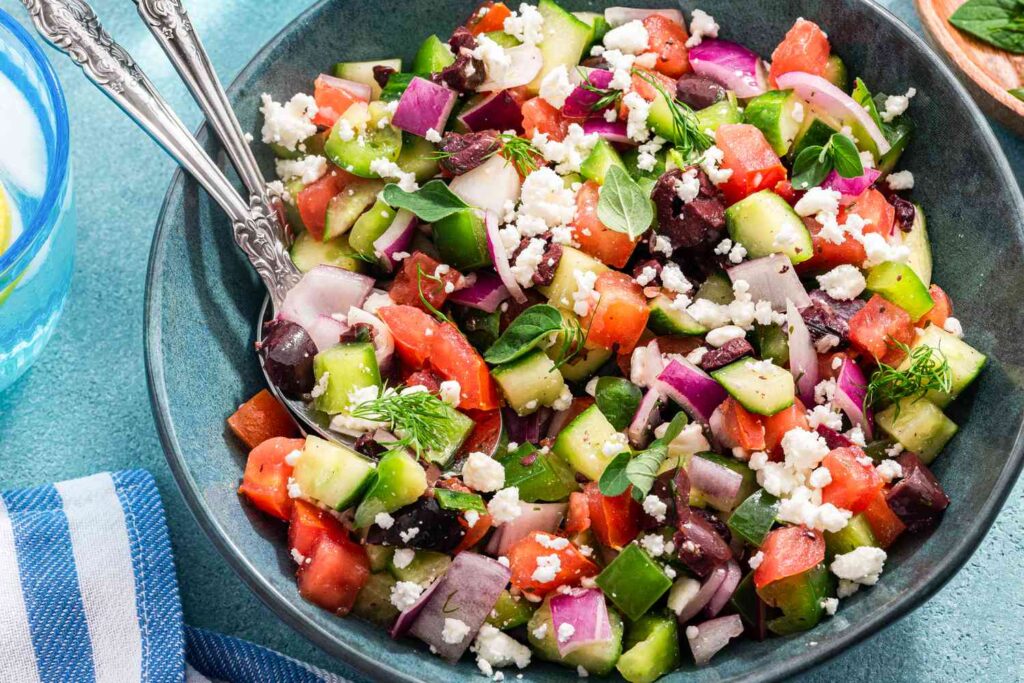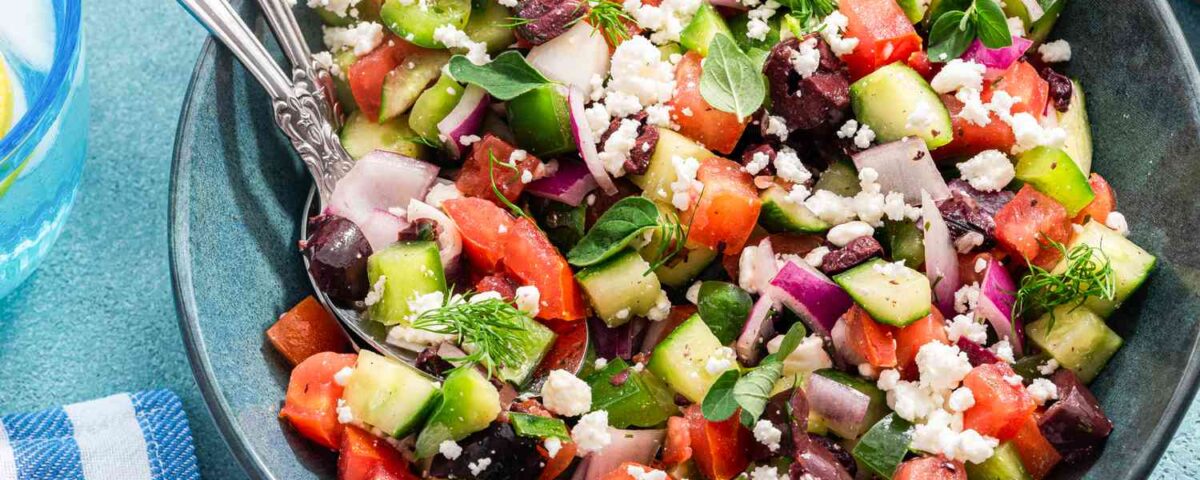The Ultimate Guide to Greek Salad
When most people think of Greek cuisine, one dish that often comes to mind is the refreshing and colourful Greek Salad. Known in Greece as “Horiatiki,” this iconic salad is a staple in Greek households and has gained popularity worldwide. What makes Greek Salad so beloved? Is it the crunchy vegetables, the crumbly feta cheese, or the tangy dressing? In this comprehensive guide, we’ll explore all facets of Greek Salad, from its rich history and traditional ingredients to variations and health benefits. Whether you’re a home cook looking to perfect your recipe or a food enthusiast wanting to delve deeper into its origins, this article has something for everyone.

A Brief History of Greek Salad
Greek Salad’s origins date back to ancient Greece, where it was common to enjoy fresh vegetables along with various forms of cheese and olives. The dish evolved over centuries, incorporating local produce and customs to become the Horiatiki we know today. Although its roots are humble, Greek Salad is often served in both casual and formal settings in Greece, signifying its importance in the Greek culinary tradition.
Why “Horiatiki”?
The word “Horiatiki” translates to “village” or “peasant” salad, reflecting its simple yet hearty ingredients. Historically, it was a way for rural Greek villagers to use readily available produce, which led to the creation of this authentically rustic dish.
Traditional Ingredients
A classic Greek Salad boasts a medley of fresh, vibrant ingredients. Here’s a breakdown of the essentials:
Tomatoes
Ripe, juicy tomatoes serve as the foundation of Greek Salad. They are typically cut into wedges or large chunks, allowing their natural sweetness to shine.
Cucumbers
Crisp cucumber slices contribute a refreshing crunch to the salad. Some recipes recommend peeling them while others prefer leaving the skin on for added texture.
Red Onions
Sliced red onions offer a sharp contrast to the sweet tomatoes and cucumbers. If you find the flavor too overpowering, a quick soak in cold water can mellow their bite.
Kalamata Olives
Kalamata olives are arguably the most indispensable ingredient, providing a savory brininess that complements the freshness of the vegetables.
Green Bell Peppers
Optional but traditional, green bell peppers add another layer of crunch and a slight bitterness.
Feta Cheese
Authentic Greek feta cheese is a must. Crumbled or cut into large blocks, its salty, tangy flavor elevates the dish tremendously.
Olive Oil
High-quality extra virgin olive oil is poured liberally over the salad, binding all the ingredients together and enhancing their natural flavors.
Oregano
Dried oregano, often sourced from the Greek mountains, adds an earthy aroma and depth to the salad.
Optional Ingredients
Some variations include capers, anchovies, or parsley, but the basic ingredients listed above make up the core of a traditional Greek Salad.
How to Make Greek Salad
Making a Greek Salad is straightforward, but attention to detail can elevate your dish from good to exceptional. Here is a step-by-step guide:
Ingredients
- 4 ripe tomatoes, cut into wedges
- 1 cucumber, sliced
- 1/2 red onion, thinly sliced
- 1 green bell pepper, thinly sliced (optional)
- 12 Kalamata olives
- 200 grams feta cheese, crumbled or in blocks
- 4 tablespoons extra virgin olive oil
- 1 teaspoon dried oregano
- Salt and pepper to taste
Instructions
- Prepare the Vegetables: Wash all the vegetables thoroughly. Cut the tomatoes into wedges, slice the cucumber into half-moons or rounds, and thinly slice the red onion and green bell pepper.
- Combine the Ingredients: In a large bowl, combine the tomatoes, cucumber, red onions, green bell pepper (if using), and Kalamata olives.
- Add the Feta: Crumble the feta cheese over the salad or place it in large blocks as traditionally done.
- Season and Dress: Drizzle the extra virgin olive oil generously over the salad. Sprinkle dried oregano, salt, and pepper to taste. Toss gently to combine.
- Serve: Serve immediately, ensuring each serving includes a mix of vegetables, olives, and feta.
Health Benefits of Greek Salad
Greek Salad is not just a feast for the senses; it’s also a nutritional powerhouse. Here are some of its health benefits:
Rich in Nutrients
- Tomatoes: High in vitamins A, C, and K, tomatoes also provide antioxidants like lycopene.
- Cucumbers: Low in calories but high in vitamins K and C, as well as minerals like potassium.
- Red Onions: Contain quercetin, an antioxidant that fights inflammation.
- Kalamata Olives: Packed with healthy fats, particularly monounsaturated fats that are good for heart health.
- Feta Cheese: A good source of protein and calcium, though it is also salty, so moderation is key.
Healthy Fats
The extra virgin olive oil in Greek Salad is rich in monounsaturated fats, which are known to reduce bad cholesterol levels and lower the risk of heart disease.
Low in Calories
Greek Salad is naturally low in calories, making it an excellent choice for those looking to maintain or lose weight without sacrificing flavor.
Antioxidant Properties
The combination of vegetables, olives, and olive oil provides a plethora of antioxidants that combat oxidative stress and may reduce the risk of chronic diseases.
Hydration
Cucumbers and tomatoes have high water content, helping to keep you hydrated, especially during hot summer months.
Variations of Greek Salad
While the traditional recipe is loved by many, various regions and chefs have added their own twists to Greek Salad. Here are a few popular variations:
Greek Pasta Salad
Transform the classic into a more substantial dish by adding pasta. Use rotini or penne, and incorporate the traditional ingredients along with a lemon-olive oil dressing.
Chickpea Greek Salad
For a protein boost, add canned chickpeas to the salad. This variation is fulfilling and adds a different texture.
Lettuce-based Greek Salad
Though not traditional, adding romaine or iceberg lettuce can create a more voluminous salad without significantly altering its taste.
Grilled Greek Salad
Grill the vegetables before combining them for a smoky, charred flavor that adds complexity to the dish.
Pairing Suggestions
Greek Salad is versatile enough to be served as a side dish or enjoyed as a main course. Here are some pairing suggestions:
With Grilled Meats
The freshness of Greek Salad pairs perfectly with grilled meats like lamb chops, chicken souvlaki, or pork skewers.
As Part of a Mezze Platter
Combine Greek Salad with other Greek appetizers such as tzatziki, hummus, and dolmades for an appealing mezze spread.
With Seafood
Complement the briny flavors of Greek Salad with grilled or baked fish, shrimp, or calamari.
Alongside Bread
Serve it with crusty bread or pita to soak up the delicious juices and olive oil from the salad.
Conclusion
Greek Salad, with its vibrant colors, refreshing flavors, and nutritional benefits, is more than just a dish; it’s a celebration of Greek culinary tradition. Whether you stick to the classic recipe or experiment with variations, this versatile salad is sure to become a staple in your kitchen. Enjoy it as a side dish, a main course, or part of a larger meal, and savor the taste of Greece in every bite.
Happy cooking, and Kali Orexi (good appetite)!
By incorporating this content into your culinary repertoire, you not only get to enjoy a delicious meal but also immerse yourself in a piece of rich cultural history. The Greek Salad is a testament to the idea that simple ingredients, when combined thoughtfully, can create a dish that is both timeless and universally loved.





3 Comments
[…] cheese adds a punch of flavor to salads. The classic Greek salad with tomatoes, cucumbers, olives, and oregano is incomplete without generous chunks of […]
[…] you think of Greek cuisine, images of fresh salads, sizzling souvlaki, and rich moussaka might spring to mind. However, there’s a lesser-known […]
[…] The Ultimate Guide to Greek Salad […]